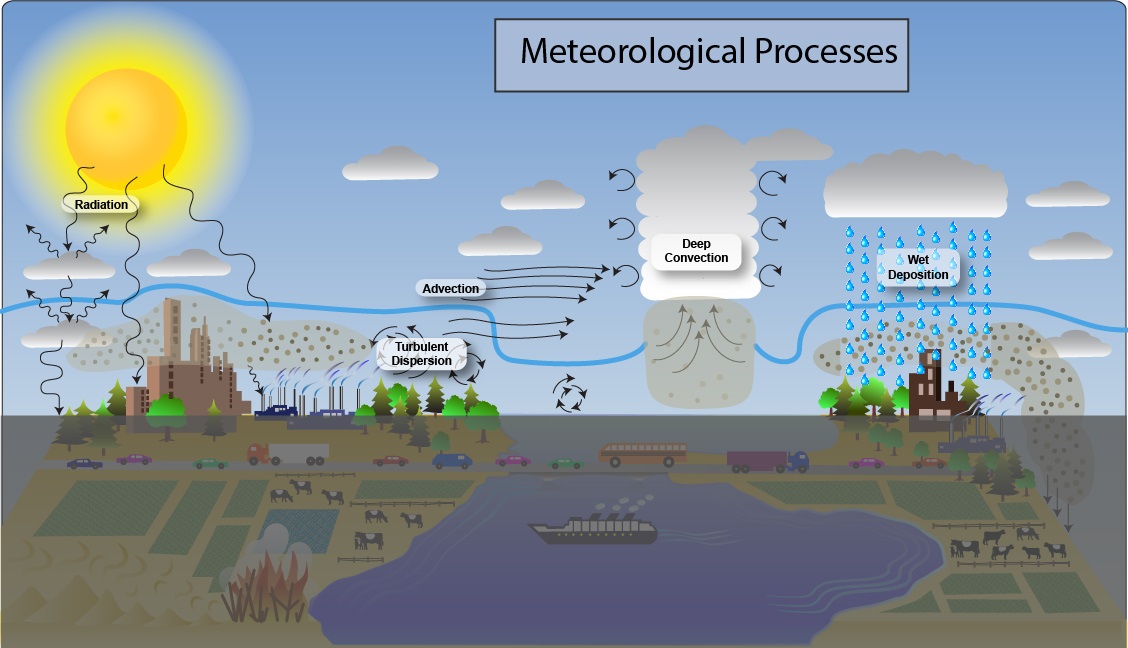Understanding Meteorology: A Comprehensive Overview
Meteorology is the scientific study of the Earth's atmosphere, focusing particularly on weather and its various phenomena. Meteorologists, the experts in this field, analyze and interpret atmospheric conditions to understand better the numerous factors that influence our weather and climate.
 |
| IMAGE SOURCE |
Branches of Meteorology
Meteorology is divided into several branches, each focusing on different aspects of atmospheric study:
- Physical Meteorology: Investigates phenomena such as cloud formation, precipitation (e.g., rain, thunderstorms), and lightning.
- Dynamic Meteorology: Concentrates on wind patterns and the governing laws of atmospheric motion.
- Agricultural Meteorology: Examines the relationship between weather and its effects on crops and vegetation.
- Micrometeorology: Studies atmospheric conditions over smaller areas, typically less than 1 square kilometer (0.4 square miles).
Composition of Air
The Earth's atmosphere comprises several gases, with the primary constituents being:
- Nitrogen: Approximately 78%
- Oxygen: About 21%
- Argon and Others: The remaining 1% includes trace gases like hydrogen, ozone, methane, and carbon dioxide.
Notably, the concentration of carbon dioxide has nearly doubled since 1900, raising concerns over climate change and its impacts (U.S. Environmental Protection Agency, 2021).
Air Pressure
Air pressure is the weight of the air molecules exerted on a unit area due to gravity. It typically decreases with altitude, having significant implications for weather patterns. Barometers measure air pressure, while anemometers gauge wind speed.
Wind & Humidity
Wind is defined as the horizontal movement of air, caused by atmospheric pressure differences stemming from temperature variations. Various instruments measure humidity, the water vapor content in the air, through metrics like absolute humidity, specific humidity, and relative humidity.
- Relative Humidity: The ratio of the current water vapor content to the maximum possible at a given temperature.
- Hygrometers: Devices used to measure atmospheric humidity.
Understanding humidity is crucial as it influences weather patterns and affects drying processes; when temperature rises but vapor content remains constant, relative humidity decreases.
Temperature vs. Heat
Meteorology distinguishes between temperature, the measure of how hot or cold something is, and heat, the energy transfer related to temperature differences. The formulas for converting between Celsius and Fahrenheit are:
- Celsius to Fahrenheit:
- Fahrenheit to Celsius:
In the atmosphere, temperature can behave differently at various altitudes; in the troposphere and mesosphere, temperatures decrease with height, while they tend to increase in the stratosphere and thermosphere, leading to phenomena like temperature inversions.
The Troposphere and Climatic Zones
The troposphere is the lowest atmospheric layer, where all weather occurs. It is characterized by:
- Temperature Decline: Approximately 6.5°C per 1,000 meters.
- Major Mass and Water Vapor: Contains about 75% of the atmosphere's mass and most of its water vapor.
Climatic Zones
Climatic zones are categorized based on temperature and precipitation:
- Tropical: Average temperatures above 20°C year-round.
- Subtropical: Warm for 4-11 months; cooler during other months.
- Temperate: Typically between 10-20°C.
- Cold: Yearly temperatures that drop below 10°C for several months.
- Polar: Consistently below 10°C.
These classifications help differentiate the weather patterns and ecosystems present in diverse geographic areas.
Climate vs. Weather
Weather refers to day-to-day atmospheric conditions, while climate denotes the long-term average of these conditions over time. Key weather elements include temperature, humidity, precipitation, wind, and atmospheric pressure.
Meteorological instruments such as thermometers, rain gauges, and barometers facilitate the measurement of weather, while climate assessment relies on long-term statistical data (National Oceanic and Atmospheric Administration, 2023).
What Influences Climate?
Climate is affected by various factors, including:
- Latitude: Determines solar radiation received.
- Elevation: Higher altitudes generally experience cooler temperatures.
- Geographic Factors: Proximity to oceans and mountains influences temperature and precipitation patterns.
Human activities, including greenhouse gas emissions, also impact climate, altering surface conditions and introducing pollutants (Intergovernmental Panel on Climate Change, 2021).
Conclusion
Understanding meteorology is crucial for predicting weather patterns, studying climate variations, and comprehensively grasping the atmospheric phenomena influencing our environment. With the continued evolution of technology and science, meteorology will play an essential role in addressing climate change and its global implications.



.png)

0 Comments